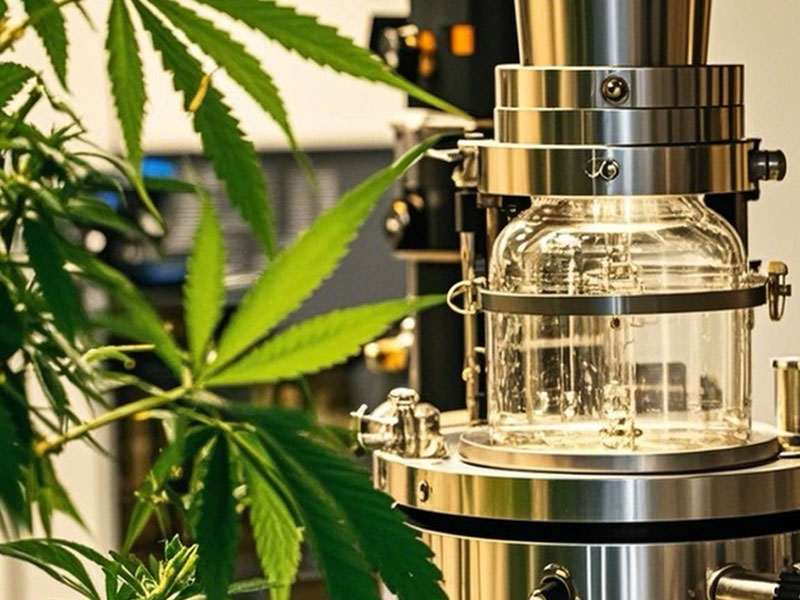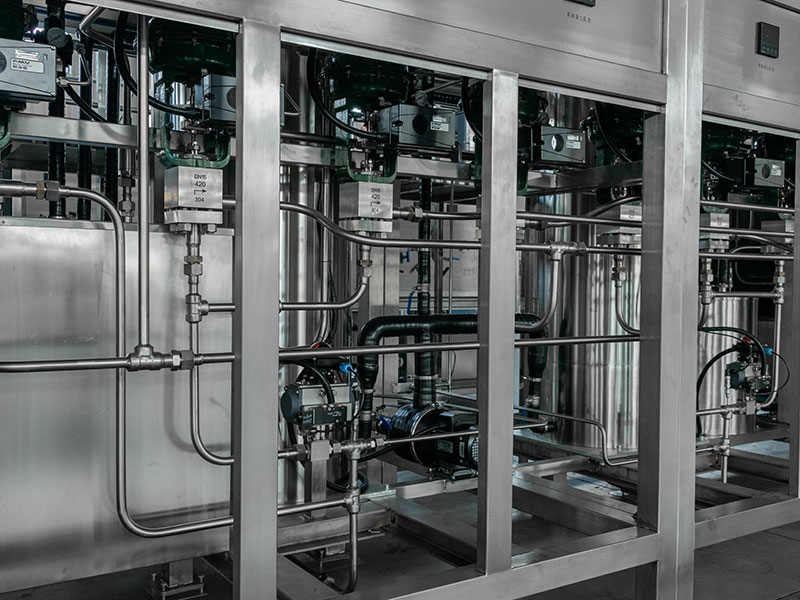CBD oil is widely recognized for its potential therapeutic benefits, and the extraction method plays a crucial role in determining its final quality and purity. CO₂ extraction, particularly supercritical CO₂ extraction, is considered the industry’s top choice among various extraction techniques. It is a cleaner, more environmentally friendly, and highly efficient method, often called the gold standard for purity and safety.

What is CBD Oil?
CBD (Cannabidiol) oil is a natural extract derived from the Cannabis sativa plant. It contains cannabidiol, a non-psychoactive compound known for its potential health benefits. Unlike THC (tetrahydrocannabinol), which induces a “high,” CBD does not produce intoxicating effects.
Common CBD Oil Extraction Methods
The extraction process significantly impacts the purity, potency, flavor, safety, and cost of the final CBD product. There are three main extraction methods:
- CO2 Extraction – The highest purity, environmentally friendly, and best suited for premium products.
- Ethanol Extraction – Balances cost and efficiency, commonly used in mid- to high-end markets.
- Solvent Extraction (Butane, Hexane, etc.) – Lower cost but poses potential solvent residue risks.
Below, we analyze the principles, pros and cons, applications, and impact of each method on the final CBD oil quality.
1. CO2 Extraction: The Best Choice
How It Works
CO2 extraction utilizes supercritical CO2 or subcritical CO2 as a solvent to dissolve and separate CBD and other active compounds from the cannabis plant under specific temperature and pressure conditions.
- Supercritical CO2 Extraction: At high pressure and moderate-to-high temperatures (above 31°C), CO2 becomes a “supercritical fluid” with both gas-like diffusivity and liquid-like solubility, efficiently extracting CBD and other beneficial compounds.
- Subcritical CO2 Extraction: Conducted at lower temperatures and pressures, this method is slower but better preserves heat-sensitive compounds such as terpenes and flavonoids.
Advantages
- ✅ High Purity, No Solvent Residue – CO2 is a natural gas that leaves no chemical solvent residues after extraction.
- ✅ Eco-Friendly and Recyclable – CO2 can be reused, and the process is environmentally sustainable.
- ✅ Precision Extraction – Temperature and pressure adjustments allow selective extraction of CBD, terpenes, and other active compounds.
- ✅ Longer Shelf Life – Low-temperature extraction prevents oxidation loss, ensuring better CBD oil stability.
- ✅ Pharmaceutical-Grade Quality – Used in high-end CBD products such as pharmaceutical-grade CBD oil and food-grade extracts.
Disadvantages
- ❌ High Equipment Cost – Supercritical CO2 extraction systems are expensive, requiring significant initial investment.
- ❌ Slower Extraction Process – Compared to solvent extraction, CO2 extraction takes longer, affecting production yield.
Applications
- ✔ Premium CBD Oil (Full-Spectrum & Broad-Spectrum CBD)
- ✔ Pharmaceutical-Grade CBD Extracts
- ✔ High-Quality Products in Food, Skincare, and Cosmetics
Supercritical vs. Subcritical CO2 Extraction
Supercritical CO₂ extraction operates at higher temperatures and pressures, while subcritical CO₂ extraction uses lower temperatures and pressures, keeping CO₂ in a liquid state. Subcritical extraction is gentler and better preserves volatile compounds like certain terpenes, but it has a lower yield and requires more time. Choosing between the two depends on the desired product characteristics. [Read More]
2. Ethanol Extraction: Cost-Effective and Efficient
How It Works
Ethanol (alcohol) is a polar solvent capable of dissolving CBD, terpenes, flavonoids, and other active compounds. The process typically involves:
- Soaking: The plant material is soaked in food-grade or pharmaceutical-grade ethanol to dissolve the target compounds.
- Filtration: Plant residues are removed, leaving an ethanol solution containing CBD.
- Distillation/Evaporation: Ethanol is evaporated via heating to concentrate the CBD oil and remove solvent residues.
Advantages
- ✅ Efficient Extraction – Ethanol dissolves CBD, terpenes, and flavonoids simultaneously, improving yield.
- ✅ Lower Cost – Requires less expensive equipment compared to CO₂ extraction.
- ✅ Food & Pharmaceutical-Grade Safety – As long as ethanol is fully removed, the final product meets safety standards.
Disadvantages
- ❌ May Affect Flavor and Color – Ethanol dissolves chlorophyll, giving the final CBD oil a darker color and potential bitterness.
- ❌ Complex Post-Processing – Requires additional distillation or filtration to remove ethanol, increasing production costs.
- ❌ Solvent Residue Risk – Incomplete ethanol removal can affect product purity.
Applications
- ✔ Mid-Cost CBD Oil
- ✔ Food Additives & Supplements
- ✔ Pharmaceutical Applications (Strict Solvent Removal Required)
3. Solvent Extraction (Butane, Hexane, etc.): Low Cost with Safety Concerns
How It Works
This method uses butane (BHO), hexane, propane, or other organic solvents to dissolve CBD and other compounds, followed by solvent evaporation to leave CBD oil.
Advantages
- ✅ Low Cost & High Efficiency – Affordable equipment and solvents make large-scale production feasible.
- ✅ High Extraction Yield – It can dissolve large amounts of CBD and terpenes.
Disadvantages
- ❌ Toxic Solvent Residue – If solvents are not fully removed, they may pose health risks, including carcinogenic effects.
- ❌ Safety Risks – Butane and similar solvents are highly flammable and explosive.
- ❌ Poor Flavor Quality – It may extract unwanted impurities, affecting CBD oil quality.
- ❌ Environmentally Harmful – Chemical solvents can contribute to environmental pollution.
Applications
- ✔ Low-End CBD Products (e.g., Cheap Vape Oils or Industrial Use)
- ✔ Industrial Applications (e.g., Textiles, Plastics, etc.)
Understanding CO2 Extraction
CO₂ extraction utilizes supercritical CO₂ (which exhibits properties of both gas and liquid) to extract cannabinoids and other valuable compounds from the cannabis plant. In this state, CO₂ permeates plant material like a gas while dissolving compounds like a liquid, making it an effective extraction solvent.
Supercritical CO2 Extraction Process
The process involves several key steps:
- Preparation: Grinding and loading high-quality cannabis material into the extraction chamber.
- Pressurization: CO2 gas is compressed and heated to reach a supercritical state before being introduced into the extraction chamber.
- Extraction: Supercritical CO2 penetrates plant material, dissolving cannabinoids, terpenes, and other compounds.
- Separation: The CO₂ and extracted compounds enter a separator, where CO₂ reverts to a gas, leaving the extracted oil behind for collection. The CO₂ gas is usually recycled for further extraction.

Post-Extraction Processing: Winterization
Following extraction, the oil may contain unwanted fats, waxes, and lipids. The winterization process refines the extract:
- Mixing with Ethanol: The Crude extract is mixed with ethanol to dilute the oil.
- Freezing: The mixture is frozen, solidifying fats and waxes.
- Filtration: Solid impurities are filtered out, leaving purified oil.
- Ethanol Removal: The Remaining ethanol is evaporated using a rotary evaporator to yield the final CBD oil.
Conclusion
Supercritical CO2 extraction has become the gold standard for producing high-quality CBD oil. Its ability to precisely and safely extract desired compounds without solvent residues, coupled with its environmental benefits, makes it the best choice in the cannabis industry. As demand for CBD products grows, clean and efficient extraction methods like supercritical CO₂ will remain essential.
FAQs
Q1: Why is CO2 extraction considered the best method?
A: CO2 extraction ensures high purity, eliminates solvent residue risks, and is environmentally friendly. It also allows precise extraction control, producing pharmaceutical-grade CBD oil.
Q2: How does ethanol extraction compare to CO2 extraction?
A: Ethanol extraction is cost-effective but may extract chlorophyll, affecting flavor and color. CO2 extraction, on the other hand, produces higher-purity CBD oil with better control over active compounds.
Q3: Is solvent extraction safe?
A: Solvent extraction is cost-efficient but poses safety concerns due to potential toxic residue and flammability risks. It is not recommended for high-quality CBD products.
Q4: What is the difference between full-spectrum, broad-spectrum, and CBD isolate?
A:
- Full-spectrum CBD contains all cannabinoids, including a small amount of THC (below legal limits).
- Broad-spectrum CBD includes multiple cannabinoids but no THC.
- CBD isolate is pure CBD with no other compounds.
Q5: Which CBD extraction method is best for medical use?
A: CO2 extraction is the preferred choice for medical applications due to its purity, precision, and lack of solvent residue.